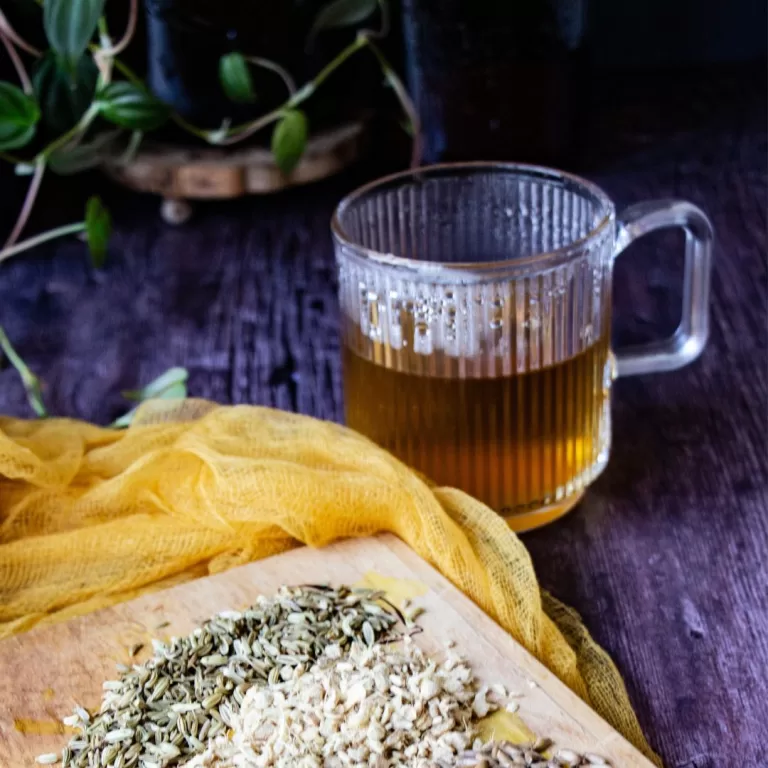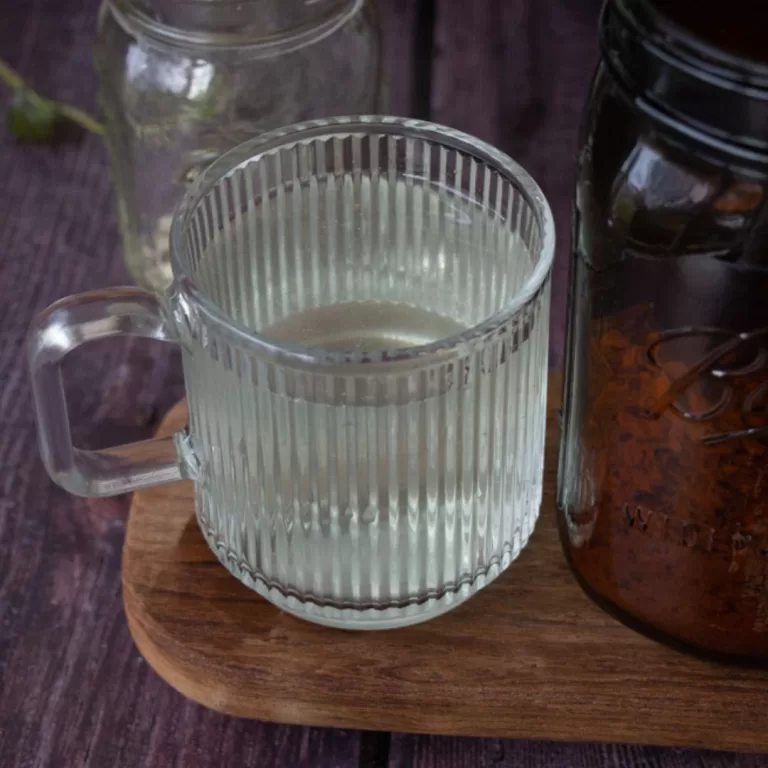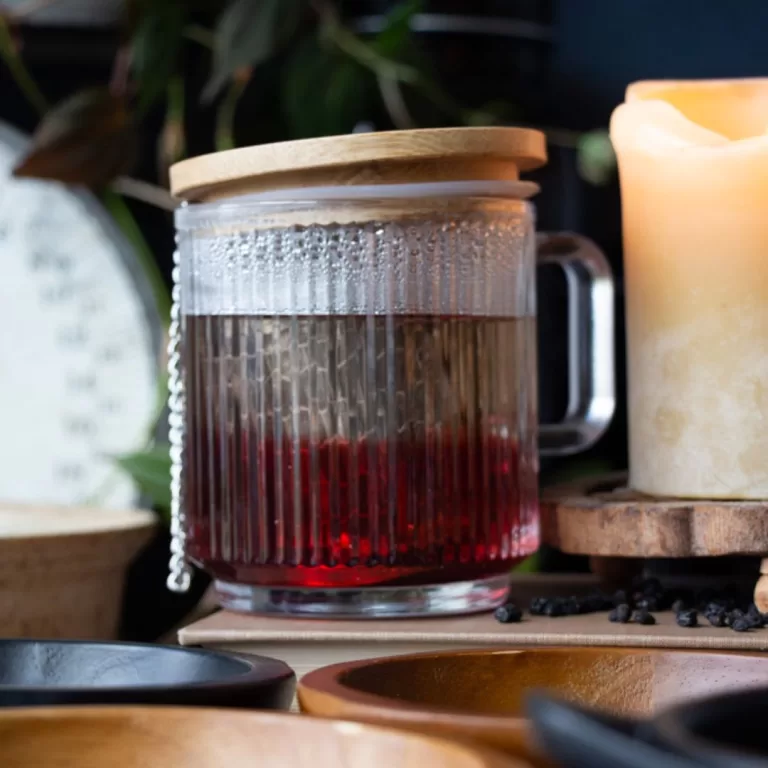DIY Mugwort Tincture for Period Bloat: Natural Menstrual Relief
As someone who has struggled with painful cramps and period bloating for years, I was thrilled to learn about using a mugwort tincture as an all-natural remedy.
If you’re like me, you know how uncomfortable and even painful bloat and cramping can be during your menstrual cycle, and finding an effective solution can be truly life-changing. This mugwort tincture for period bloat is super easy to make and an excellent addition to your herbal medicine cabinet.
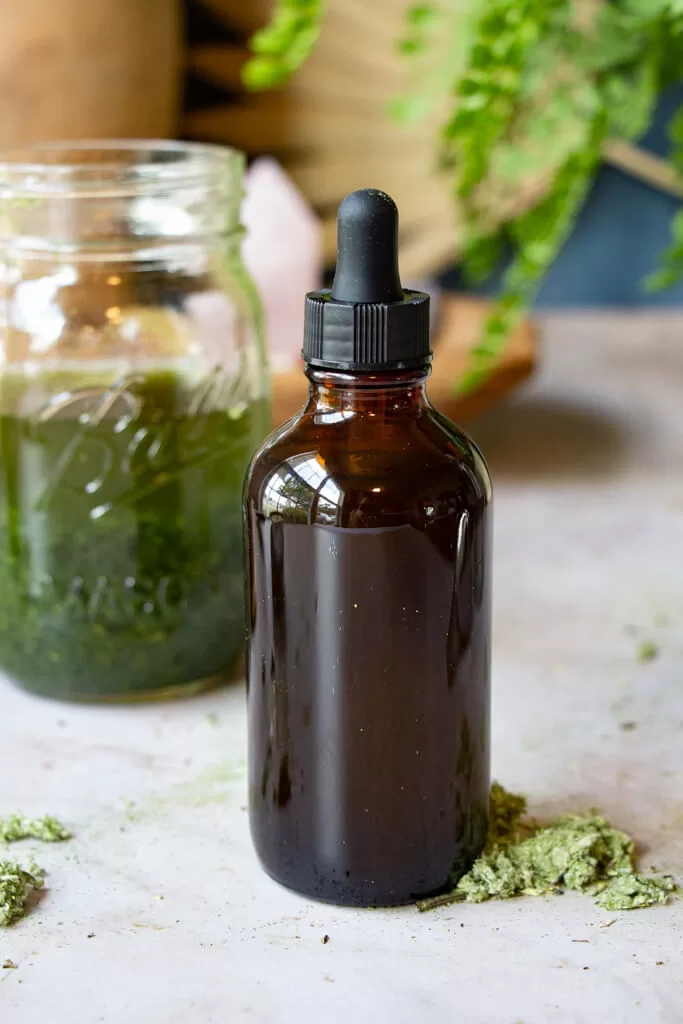
This amazing herb, known scientifically as Artemisia vulgaris, has a long history of use in traditional medical practices. One of its primary benefits is its ability to alleviate period symptoms and associated discomfort. The tincture form of mugwort is a concentrated extract that offers a convenient and easy way to experience its therapeutic effects.
Mugwort is a perennial herbaceous plant that belongs to the Asteraceae family (aka the Daisy family). It is native to Europe, Asia, and North Africa but can now be found in various regions around the world. Mugwort has a long history of traditional use in herbal medicine due to its potential medicinal properties, and it is known for its feathery, aromatic leaves and small yellowish flowers.
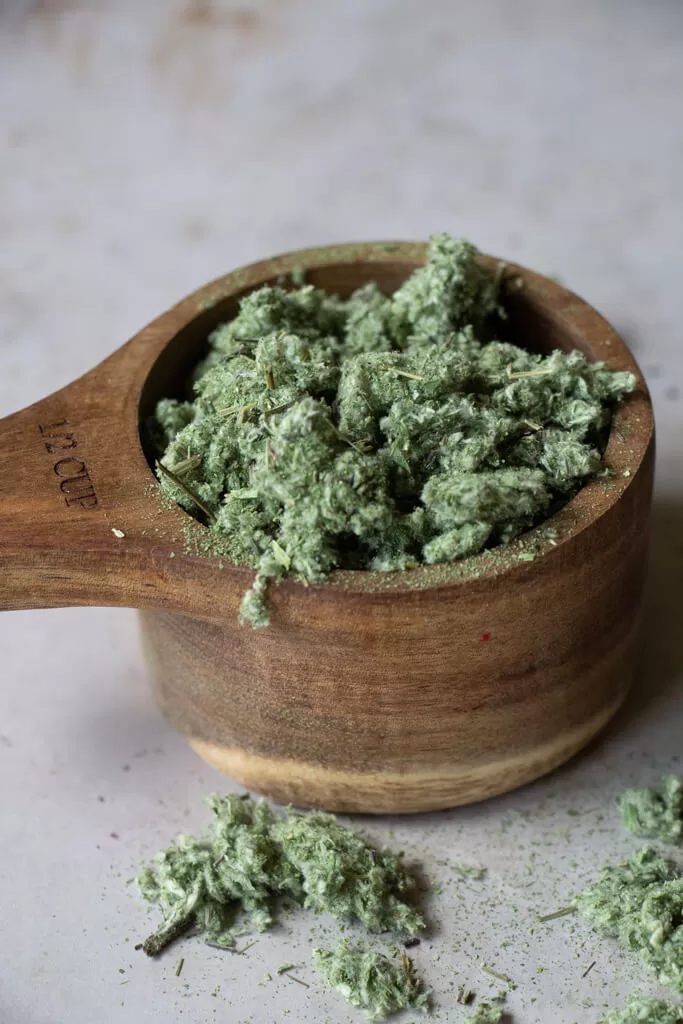
I hope this information will help others find relief like I did, and perhaps even make that time of the month a little more bearable! Seriously… I just started learning more about my period after I hit 30! Now that I know more about my personal flow, I know that every other month, I need a little help from my herbal friends!
Medical disclaimer: I am not a medical professional and I am not claiming that these herbs are a substitute for professional care. Always consult a professional for medical advice when starting natural remedies at home. These are just things that I use and love in my own home.
Mugwort Tincture for Period Bloat
Mugwort is commonly used to manage period-related discomfort by releasing the flow from the body, relieving cramps and bloating. It is an Emmenagogue, which means it “stimulates blood flow in the pelvic area and uterus.”
What is period bloat anyways? Period bloat, also known as menstrual bloating, refers to the temporary swelling or distention of the abdomen that some people experience during their menstrual cycle. It is a common symptom associated with menstruation and is caused by hormonal changes and water retention in the body.
Reduction in bloating leads to:
- Less severe menstrual cramps
- Increased relaxation during cycle
Taking a mugwort tincture is a convenient and effective way to alleviate period bloat and menstrual discomfort. Give it a try and discover the benefits of this time-tested herbal remedy.
As an Amazon Associate, I earn from qualifying purchases. Please visit my privacy + disclosure page for more details.
Mugwort Tincture Recipe
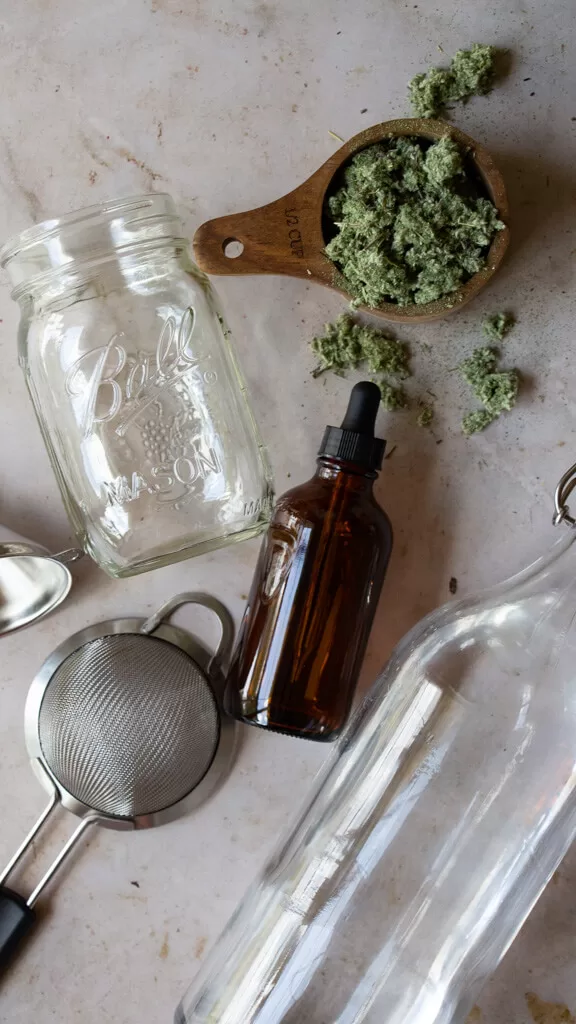
Ingredients:
Using Dried Mugwort:
- 1/2 cup dried mugwort
- 1 1/2 cups Everclear (or another high-proof alcohol such as vodka or organic grain alcohol)
Using Fresh Mugwort:
- 1 cup fresh mugwort
- 1 cup Everclear (or another high-proof alcohol such as vodka or organic grain alcohol)
Equipment:
- A glass jar with a tight-fitting lid (mason jars work well!)
- Cheesecloth or a fine-mesh strainer
- Funnel
- Amber glass bottles for storage
- Labels for the bottles
Instructions:
- Start by sterilizing the glass jar and any other equipment you’ll be using. This can be done by washing them with hot, soapy water and rinsing thoroughly.
- Place the dried mugwort leaves into the glass jar.

3. Pour the Everclear over the mugwort, making sure they are completely submerged. The alcohol should cover the herbs by about an inch.

4. Secure the lid tightly on the jar, and give it a good shake to ensure that all the herbs are coated with alcohol.
5. Store the jar in a cool, dark place, such as a pantry or cupboard, for about 6 weeks. During this time, shake the jar gently every day or every few days to help with the extraction process.
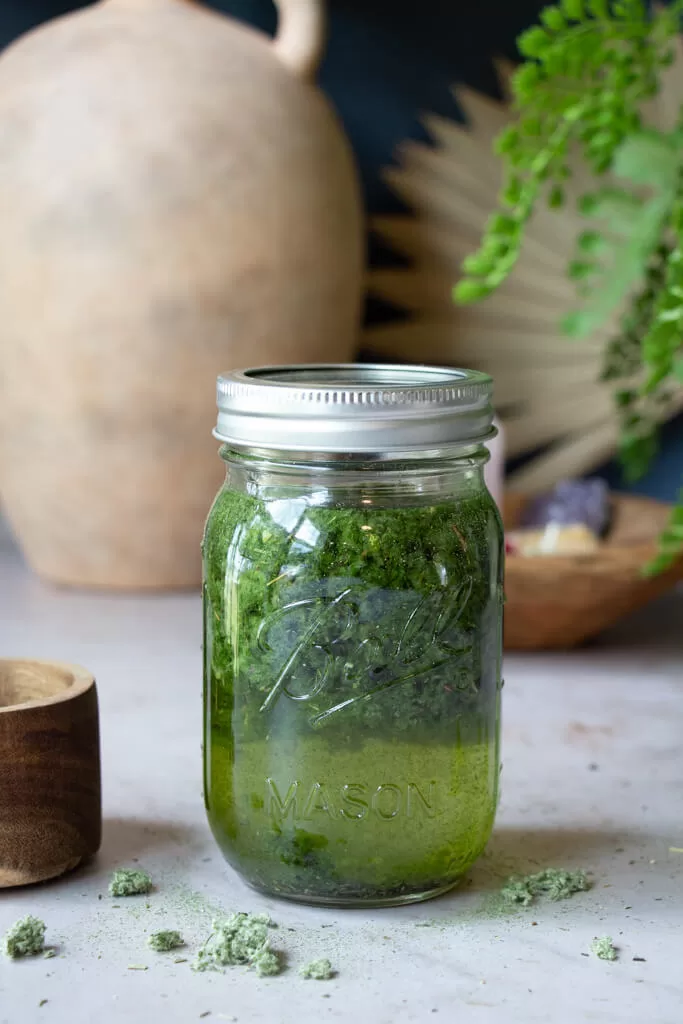
6. After the designated steeping period, prepare a straining setup. Place a funnel lined with cheesecloth or a fine-mesh strainer over a clean glass container.
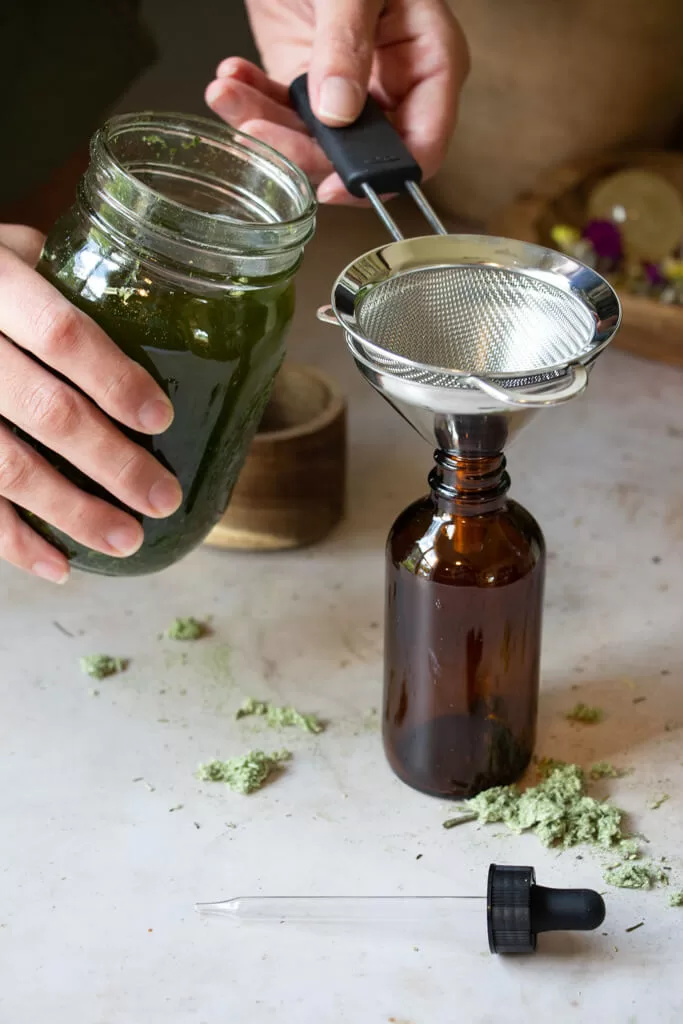
7. Pour the contents of the jar through the strainer, allowing the liquid to filter into the glass container. Squeeze the cheesecloth or strain the herbs to extract as much liquid as possible.

8. Discard the spent herbs and transfer the tincture into amber glass bottles for storage. Amber bottles help protect the tincture from light, preserving its potency.
9. Label the bottles with the name of the tincture (Mugwort Tincture) and the date of preparation.
10. Store the bottles in a cool, dark place. When stored properly, the tincture can last for several years.
Note: High-proof alcohol such as Everclear is commonly used for tincture preparations, as it aids in extracting the medicinal properties from the herbs. However, it’s important to be cautious when handling and consuming high-proof alcohol, and to use it responsibly and in moderation. If you want to consume less alcohol, you can check out this post on How to Remove Alcohol From Herbal Tinctures or prepare mugwort as an herbal tea instead.

Mugwort Tincture: Usage and Precautions
Before trying mugwort tincture for period bloat, I always recommend consulting with your healthcare provider. They can advise on the proper dosage and any potential interactions with other medications or conditions.
Dosage
Mugwort tincture should be started in small doses to gauge its effects. Typically, a dose of 1-2 droppers full, 2 to 3 times a day is a good starting point. If needed, you can gradually increase the dosage as I observe how your body responds.

Who should NOT take this tincture?
- Anyone with allergies to the daisy family. Common allergy symptoms include:
- Rash
- Itching or hives
- Swelling of the face, lips, or tongue
- Breathing difficulties
If any of these symptoms occur, stop using the tincture immediately and seek medical help.
2. Pregnant Women
- Pregnant women or those planning to become pregnant soon should avoid using mugwort tincture. It may stimulate uterine contractions, which could potentially cause a miscarriage or preterm labor.
3. Birth Control Users
- Herbs, including mugwort, can potentially interact with hormonal contraceptives or other hormonal treatments. Some herbs may have estrogenic or progesteronic effects, which could interfere with the effectiveness or mechanisms of action of hormonal medications. It is important to ensure that there are no contraindications or potential interactions between mugwort and your specific medications.
Mugwort Benefits for Menstrual Symptoms
- Mood Swings: This mugwort tincture can help with mood swings and feelings of irritability as well. Mugwort can also support the nervous system, making one feel more calm and balanced during that challenging time of the month.
- Menstrual Pain: I often experience cramps, lower back pain, and abdominal discomfort during my period. Using a mugwort tincture can help alleviate some of these discomforts through its potential anti-inflammatory properties.
- Cramp and Bloat Reduction: By improving blood circulation, mugwort can release those cramps and bloat and provide a more even flow (with less clotting). Also, it is a uterine tonic and can help release any water retention issues.
- Digestive Bitter: According to the National Library of Medicine, mugwort is “used for stimulating the secretion of digestive juices in the treatment of appetite loss, achlorhydria, gastritis, and flatulence.”
- Lucid Dreaming: Lucid dreaming is a state of awareness in which a person becomes conscious during a dream and is able to actively participate and manipulate the dream content. It allows individuals to have a sense of control and awareness within the dream world. Some people find lucid dreaming to be a fascinating and transformative experience. I have not personally experienced lucid dreaming, but that sounds like a fun time when you are feeling down!
Other Possible Herbal Benefits of Mugwort
- Digestive Support: Can support digestion and alleviate digestive discomfort. Mugwort may stimulate the production of digestive juices and enzymes, aiding in the digestion process.
- Relaxation and Sleep: Mugwort is sometimes used as a calming herb to promote relaxation and improve sleep quality. It is believed to possess mild sedative properties that can help ease tension and induce a sense of calm.
- Joint and Muscle Support: Some herbalists use mugwort externally in the form of poultices or liniments to soothe joint and muscle discomfort. It may help ease inflammation and promote relief in conditions such as arthritis or sore muscles.
- Digestive Parasite Support: Mugwort has traditionally been used as a vermifuge, which means it may help eliminate intestinal parasites. However, it’s important to consult with a healthcare professional for proper diagnosis and treatment of any parasitic infections or other issues of the digestive system.
- Antioxidant Properties: Mugwort contains various compounds with antioxidant properties, such as flavonoids and phenolic compounds. Antioxidants help protect the body’s cells from damage caused by free radicals and oxidative stress.
- Skin Health: Mugwort may have anti-inflammatory and antifungal properties that may help alleviate skin conditions like eczema, dermatitis, and itching.
Mugwort’s Historical and Cultural Significance
- Ancient cultures like the Greeks and Romans valued mugwort for its medicinal properties, using it to treat digestive issues, menstrual pain, and ward off evil spirits.
- In the Middle Ages, mugwort remained popular in Europe, believed to aid fertility and protect travelers on long journeys.
- Native Americans also used mugwort for respiratory problems, skin conditions, and menstrual pain, incorporating it into ceremonies and rituals.
- Traditional Chinese medicine (TCM) has long used mugwort to manage period-related discomfort, alleviating cramps and bloating by releasing the flow from the body.
More Mugwort Preparations for Periods:
- Mugwort tea: You can prepare an herbal tea with mugwort, which will enhance its de-bloating effects even further through increasing hydration.
- Mugwort bath: You can add mugwort to an herbal bath soak, like chamomile bath salts, to reap its menstrual relief effects.
Other Natural Menstrual Relief Remedies
Other Herbs for PMS
Black Cohosh, red raspberry leaf, and cramp bark are just a few other herbs for menstrual relief. If you want more information check out this post on the Best Herbs for Common Menstual Problems.
Other Natural PMS Remedies
Alongside the use of mugwort tincture, there are several lifestyle changes and practices that can complement its effects and contribute to overall menstrual relief.
- Balanced Diet: Adopting a balanced and nutritious diet can support hormonal balance and overall well-being during your menstrual cycle. Focus on consuming a variety of fruits, vegetables, whole grains, lean proteins, and healthy fats. Incorporate foods rich in magnesium, calcium, and omega-3 fatty acids, as they may help alleviate menstrual symptoms.
- Regular Exercise: Engaging in regular physical activity can promote blood circulation and reduce menstrual discomfort. Consider incorporating exercises such as walking, jogging, yoga, or gentle stretching into your routine. Find activities that you enjoy and aim for at least 30 minutes of exercise most days of the week.
- Stress Management: Stress can exacerbate menstrual symptoms, so it’s important to prioritize stress management techniques. Explore relaxation practices such as deep breathing exercises, meditation, mindfulness, or engaging in hobbies that bring you joy and relaxation. Adequate sleep and self-care practices are also crucial for managing stress levels.
- Heat Therapy: Applying heat to the lower abdomen or back can help alleviate menstrual cramps. You can use a heating pad, hot water bottle, or take warm baths to relax tense muscles and reduce pain.
- Hydration: Staying well-hydrated throughout your menstrual cycle is essential. Drinking an adequate amount of water can help reduce bloating and water retention. Aim to drink at least eight glasses of water per day and limit the consumption of caffeine and sugary beverages.
- Herbal Teas: In addition to mugwort tincture, you can explore other herbal teas known for their soothing properties during menstruation. Chamomile, ginger, peppermint, and raspberry leaf tea are popular options that may help alleviate menstrual discomfort.
- Relaxation Techniques: Engaging in relaxation techniques such as deep breathing exercises, progressive muscle relaxation, or guided imagery can help calm the body and mind, reducing the intensity of menstrual symptoms.
Try this Mugwort Tincture for Period Bloat!
Remember, every individual is unique, and it may take some trial and error to find the combination of lifestyle changes and practices that work best for you. It’s always a good idea to listen to your body, seek support from healthcare professionals, and make adjustments based on your specific needs and preferences. By incorporating these lifestyle changes alongside mugwort tincture, you can enhance your menstrual relief and promote overall well-being.
The world of medicinal herbs holds a treasure trove of natural remedies that can provide relief for various ailments. When it comes to painful periods and the discomfort of bloating, mugwort tincture shines as a promising option. Its historical use in traditional medicine practices, coupled with its reported benefits, make it an intriguing choice for those seeking natural menstrual relief.
The good news is that mugwort tincture offers a convenient and effective solution for period bloat. By harnessing its potential as an Emmenagogue, it may stimulate blood flow in the pelvic area and uterus, leading to a reduction in bloating and less severe menstrual cramps. Additionally, the potential for increased relaxation during the menstrual cycle adds an extra layer of comfort and well-being.
Pin Mugwort Tincture for Period Bloat for Later!


About the Author:
I’m Brittany, totally modern and mainstream turned crunchy mama!
Read more here about how I went from a totally incompetent cook and hyper-consumer to striving to live a more meaningful life from scratch.
I can’t wait to share my modern homesteading journey with you and I hope I inspire you to join along!

